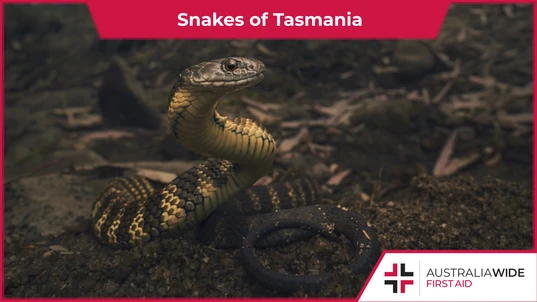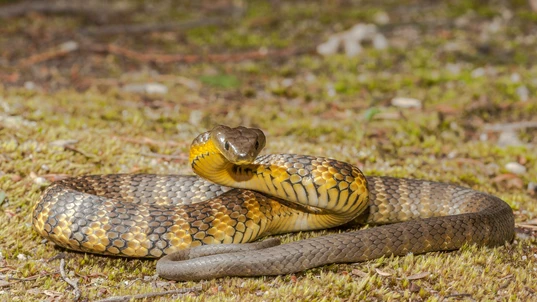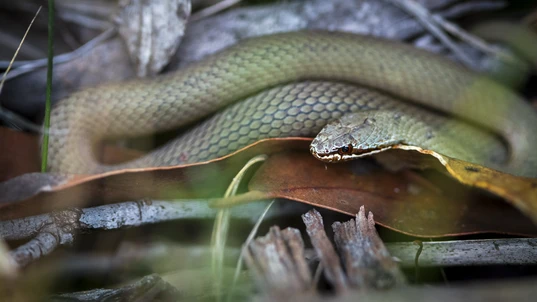First Aid for the Snakes of Tasmania

Bites and Stings

Tasmania is home to three species of snake: the Tiger snake, the Lowland copperhead snake, and the White lipped snake. These three snake species are all cold adapted and have highly neurotoxic venom.
Tasmania is home to three snake species: the Tiger snake, the Lowland copperhead snake, and the White lipped snake. These three snakes have dark colouration to absorb heat more efficiently in Tasmania's cold climate. Likewise, they have highly toxic venom that can adversely affect nerve cells, including those in the heart and lungs. It is important to remember, however, that these snakes are unlikely to attack people except in the case of severe harassment. In this article, we will help you stay snake bite-safe in Tasmania by providing information about:- The identifying characteristics and preferred habitat of Tasmanian snakes
- The first aid management of snake bites

Though Tiger snakes are renowned for prominent yellow and black cross-bands along their back and sides, not all individuals have this pattern. As well as being neurotoxic, their venom can also cause blood clots.
The Tiger snake
The Tiger snake (Notechis scutatus) commonly has the following identifying characteristics:- Thick, muscular body that generally ranges from 1 to 1.5 m long
- A wide, deep head that is almost imperceptible from the body
- Their body scales can range from dark olive brown to black
- A series of bands along their body that can range from off-white to yellowish (though some individuals may be entirely 'band-less')
- Watery environments, such as creeks, rivers, or swamps
- Highly degraded areas, such as pastoral lands

Australia is home to several Copperhead species, including the Pygmy copperhead, the Highland copperhead, and the Lowland copperhead (pictured). All Copperhead venom is toxic to nerve cells, red blood cells, and other living cells.
The Lowland copperhead snake
The Lowland copperhead snake (Austrelaps Superbus) is similar in form and colouration to other species of Copperhead and has the following identifying characteristics:- A muscular, moderately robust body that can reach a total length of 1.45 m
- Semi-glossy scales on their back and sides that are uniformly grey brown to blackish in colour, sometimes with a brownish or orange flush
- The lowermost rows of scales on their sides are enlarged and typically paler in colour, while their belly colour can range from cream to grey
- As their name suggests, they have a coppery-brown colouration on their head, which is also narrow and almost imperceptible from their neck
- Watery environments, such as creeks, rivers, or swamps
- Heavily disturbed areas, including dams, canals, and along the verges of roads
- Grassland, woodland, and open scrub

The White lipped snake is Tasmania's smallest species of snake. They also happen to be one of the most cold-adapted snakes in the world.
The White lipped snake
The White lipped snake (Drysdalia coronoides), which are also called Whip snakes in Tasmania, have the following identifying characteristics:- A slender body that can reach a total length of 50 cm
- The scales on the back and sides of Tasmanian individuals tend to range from olive green to green grey in colour
- They generally have a pale grey or pale pink underside
- As their name suggests, they have a white stripe along the edge of their lip
- Heathland
- Grassland
- Woodland
Snake bite symptoms
Snake bite venom is intended to numb, stun, or kill prey, so it can cause the following symptoms in humans:- Puncture marks or parallel scratches on the skin, though rarely with any pain
- Discolouration around the bite site, though not always
- Pale, cool skin with the progressive onset of sweating
- Rapid, shallow breathing
- Blurred vision, drooping eyelids
- Difficulty swallowing and speaking
- Abdominal pain, nausea, and/or vomiting
- Headache
- Collapse progressing to unconsciousness
Looking to get you First Aid knowledge up to date?
We run certified First Aid courses throughout all major Acustralian citys. Find a location near you.
Snake bite first aid
It can be difficult to positively identify different snake species, as individuals of the same species can vary dramatically in colour, pattern, and size. As such, all snake bites should be treated as a medical emergency:- Keep the casualty at rest and as still as possible to stop the venom from travelling through the body.
- Constantly observe and reassure the casualty.
- Follow DRSABCD and be prepared to perform CPR
- Apply the ‘pressure immobilisation technique’ (PIT):
If the bite site is on a limb, cover it with a wide heavy elastic bandage (10 - 15 cm wide).
Ensure the bandage is firm and tight, so tight you cannot easily slide a finger between the bandage and the skin.
Apply a second heavy elastic bandage. Start from the fingers or toes and wind up the limb as far as possible. Consistent coverage (overlapping half over half) and consistent pressure (firm but not cutting off circulation) are key to an effective PIT. - Immobilise the limb and joints with a splint, or use a sling if the bite site is on an arm. Keep the limb immobilised until the ambulance arrives.
Final thoughts
Tasmania is home to three venomous species of snake: Tiger, Copperhead, and White lipped. If you sustain a bite from any of these venomous snake species, contact Triple Zero (000) for an ambulance and apply the Pressure Immobilisation Technique. You can enrol in one of our general or childcare first aid courses to learn more about snake bites. We have training locations in Tasmania and across the country - head to our website to find a location near you today.
Originally published at
https://www.australiawidefirstaid.com.au/resources/snakes-of-tasmania
as part of the Australia Wide First Aid Articles Library









